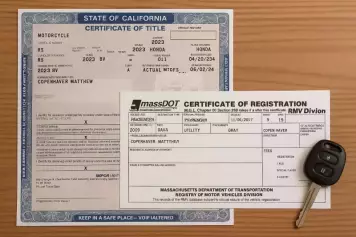You may have seen terms like FWD or AWD listed under drivetrain when checking a car’s specifications or shopping for a vehicle. Many drivers aren’t familiar with these terms or don’t know which drivetrain their car has. Understanding your vehicle’s drivetrain matters—it affects handling, resale value, fuel efficiency, and safety.
A drivetrain connects the engine to the wheels and includes the components that transfer power to move the vehicle. The drivetrain type determines how power reaches the wheels through the transmission, which influences traction.
A typical drivetrain includes the transmission, axles, driveshaft, U-joint, CV joints, and differential. The system operates differently in FWD and AWD vehicles. Whether you’re researching performance or buying a car, knowing the differences between these drivetrains will help you choose with confidence.
What Is FWD (Front-Wheel Drive)?
Front-wheel drive (FWD) is a drivetrain system in which all of an engine’s power is sent to the two front wheels, which typically steer the vehicle and move it forward. All drivetrain components in this system are housed in front of the car, increasing traction in the front wheels. The engine’s weight sits directly over the driven wheels, providing better traction on slippery or wet roads, especially when starting from a stop.
FWD vehicles are typically lighter because the major drivetrain components are concentrated in one area, which helps to improve fuel efficiency. They are also easier to maintain. Front-wheel drive is most common in midsize sedans, compact vehicles, many family-oriented cars, and hatchbacks. You will find it in car models designed for everyday driving, commuting, and fuel economy, such as the Honda Civic, Chevy Malibu, Toyota Camry, Ford Fiesta, and Hyundai Elantra.
- Pros of Front-Wheel Drive (FWD)
- Lighter weight improves fuel efficiency.
- Less aggressive handling is ideal for cautious or new drivers.
- Manufacturing and maintenance are cheaper. Fewer parts mean lower purchase prices and maintenance costs.
- Offers better and balanced traction in rain or light snow since the engine weight is mostly over the front wheels.
- Cons of Front-Wheel Drive (FWD)
- With all the weight over the front wheels, it is harder to handle at high speeds or with heavy loads, especially during sharp turns.
- Front tires usually wear faster since the front wheels do all the work.
- Not as effective or ideal in low-traction situations like mud, deep snow, rough terrain, or gravel.
What Is AWD (All-Wheel Drive)?
The all-wheel drive (AWD) drivetrain system delivers power from the engine to all four wheels of a car when required, improving stability and traction. Most vehicles with this system have the drivetrain engaged at all times, using sensors to automatically determine which wheel needs extra grip and distributing different levels of power between the rear and front wheels without the driver’s input.
An all-wheel drive system can either be full-time AWD or on-demand AWD. A full-time AWD constantly powers all four wheels of a vehicle. By contrast, an on-demand AWD system primarily drives the front wheels, switching to all-wheel drive only when sensors detect poor traction. AWD’s ability to sense when a wheel requires extra grip without the driver’s input makes it especially beneficial in snowy, icy, and rainy conditions.

Common vehicles with the AWD system include crossovers, SUVs, and some performance wagons or sedans. You will find it in cars such as the Honda CR-V AWD, Subaru Outback, Audi Quattro, BMW X5, Volkswagen Golf R, Ford Focus RS, and Toyota RAV4 AWD.
- Pros of All-Wheel Drive (AWD)
- Improved traction and stability on wet roads, snow, and uneven terrain.
- Drivers don’t need to manually engage the system, making it ideal for daily commuting.
- Better acceleration and increased driver confidence, even when driving in unpredictable weather.
- Improved handling during sharp turns.
- Cons of All-Wheel Drive (AWD)
- Extra drivetrain components make it heavier, which in turn worsens gas mileage. In other words, it has lower fuel economy.
- It cannot handle extreme off-road conditions because it lacks the low-range gearing of 4WD systems.
- AWD cars are often more expensive because they have more parts. Additionally, repairs tend to cost more due to complexity.
Key Differences Between FWD, AWD, and 4WD
Generally. FWD is the most efficient for city use, 4WD boasts unmatched capability for heavy-duty work and off-road driving, while AWD offers confidence in mixed weather. The table below shows some differences between FWD, AWD, and 4WD:
|
Feature |
Front-Wheel Drive (FWD) |
All-Wheel Drive (AWD) |
Four-Wheel Drive (4WD) |
|
Best Driving Conditions |
Paved, dry, and mild climates |
Mixed conditions, including light snow, rain, and uneven terrain |
Deep snow, mud, rough terrain, and any off-road environment |
|
Handling and Control |
Predictable, but more likely to understeer |
Balanced handling and enhanced stability |
Less agile on pavement but has strong traction |
|
Fuel Efficiency |
Highly fuel-efficient |
Moderately fuel-efficient |
Least fuel-efficient |
|
Weight |
Lightest |
Heavier than FWD |
Heaviest of them all |
|
Power Distribution |
Power travels to the front wheels only |
Power is delivered automatically to all four wheels, but uses sensors |
Power reaches all four wheels but is driver-controlled |
|
Cost and Maintenance |
Lowest purchase and maintenance cost |
Moderate purchase costs and repair expenses |
The highest purchase costs and expensive maintenance |
|
Performance in Rain/Snow |
Good traction in rain or light snow |
Better traction than FWD because the power shifts automatically for grip |
Best traction, even in slippery terrain or deep snow |
|
Driver Input/Involvement |
Fully automatic |
Fully automatic |
Manual activation to shift the drivetrain between 4L and 4H |
|
Performance Off-road |
Limited |
Moderate/mild off-road use |
Performs excellently in extreme off-road conditions |
|
Vehicle Types |
Compact cars, sedans, and hatchbacks |
SUVs, crossovers, and performance vehicles |
Off-road SUVs, work vehicles, trucks, and adventure vehicles |
How to Know What Your Car Has
Here are the steps to identify what drivetrain your car has:
- The best place to look is the owner’s manual. If you cannot find the manual, search the manufacturer’s website for the model/year PDF.
- Look for extra FWD, AWD, or 4WD markings or badges on the car. You can check the tailgate, trunk, door jamb, near the front fenders, or rear bumpers. However, this is not guaranteed, as some manufacturers don’t clearly mark the drivetrain on their vehicles.
- Inspect the car’s undercarriage for the following visual cues, but observe the necessary safety precautions:
- A rear differential housing means power travels to the rear axle (4WD or AWD).
- CV axles on all four wheels mean power is delivered to every wheel (4WD or AWD).
- A long driveshaft connecting the front to the rear differential suggests the vehicle has power going to the rear wheels (AWD or 4WD)
- No full-length driveshaft (it is most likely FWD)
- An additional gearbox or a transfer case near the transmission suggests the vehicle is a 4WD or AWD with off-road gearing.
- Conduct a VIN lookup on GoodCar VIN Decoder to identify the car’s drivetrain. The report will reveal if your car is FWD, AWD, or 4WD.
- Open the hood and check the transmission or transaxle (combined transmission and differential) area closely. Many 4WD and AWD vehicles come with a longitudinal transmission layout, while FWD cars typically have a transaxle mounted transversely across the front.
- Contact the dealer or the manufacturer’s service departments to confirm your vehicle’s drivetrain if you are unsure. They will most likely request your VIN. Alternatively, consider hiring a mechanic or an inspection service professional to help determine your car’s drivetrain.
Which Drivetrain Is Right for You?
Choosing between FWD, AWD, and 4WD depends on your driving habits, location, and the performance or efficiency features that matter most to you in a vehicle. Each drivetrain system offers unique benefits suited to different driving conditions and lifestyles.
Whether you are an off-road enthusiast or a daily commuter, here is how to decide which drivetrain is right for you:
- Front-Wheel Drive (FWD) - This drivetrain is ideal for city drivers and everyday commuters. Choose an FWD vehicle if you primarily drive on paved roads in places with mild or warm climates and are budget-conscious. Most FWD cars are easy to maintain and are highly fuel-efficient.
- All-Wheel Drive (AWD) - If you have a family or often drive in rainy or snowy climates, an AWD vehicle is a great choice. Prioritize AWD if you need traction and all-weather safety in areas with light snow, frequent rain, or seasonal weather changes.
- Four-Wheel Drive (4WD) - The 4WD system is best if you frequently drive on muddy roads, gravel, or rough terrain, as it offers maximum traction. Consider a 4WD SUV or truck if you enjoy off-road adventures, camping, or have a daily routine that involves towing or hauling.
FAQs About Drivetrains
The following are answers to some frequently asked questions about drivetrains:
Is AWD Safer Than FWD in Snow?
Yes, AWD is safer than FWD in snow. It automatically delivers power to all four wheels, enhancing stability and traction, especially on slippery roads.
Can I Turn Off AWD?
You may not be able to turn off AWD because most AWD systems are automatic.
Do 4WD Vehicles Use More Gas?
Yes, 4WD vehicles are heavier and typically consume more fuel than FWD or AWD, especially when used on dry pavement.
Can I Add AWD or 4WD to My Car?
No. Adding 4WD or AWD to a vehicle not originally built for it requires major structural and computer system changes. This is not cost-effective or practical. If traction is a priority, consider buying a 4WD or AWD vehicle.
Which Drivetrain Lasts the Longest?
FWD cars typically last the longest due to their lighter weight and fewer moving parts, but the longevity of other drivetrains largely depends on use and maintenance.
How Do I Check the Drivetrain When Buying a Used Car?
You can check a used car’s drivetrain by looking for badges such as FWD, AWD, or 4WD, checking the owner’s manual, or reviewing the VIN report obtained from GoodCar.
Is AWD Good For Snow and Ice?
Yes. AWD vehicles automatically adjust power to the wheels that need it most and are recognized for their excellent traction on icy and snowy roads.
Is FWD Good for City Driving?
Yes, FWD cars are ideal for city driving. They are typically lightweight and offer exceptional fuel efficiency, making them perfect for urban driving.
How Can I Check My Drivetrain By VIN?
You can check your vehicle’s drivetrain by conducting a VIN lookup on platforms like GoodCar. Among other information, the report will reveal whether your car has AWD, FWD, or 4WD.








![Best Sites to Check a Car’s History [2025 Review]](https://media.infopay.net/thumbnails/K8lMeG2QLjE46LPqZlmoi6SunKKdT5qvlaRZk6e1.webp)









![Best Sites to Check a Car’s History [2025 Review]](https://media.infopay.net/thumbnails/K8lMeG2QLjE46LPqZlmoi6SunKKdT5qvlaRZk6e1-w356.webp)